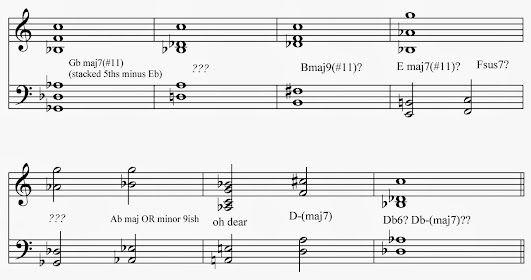Perhaps I'm too sensitive. Ok, yes, I'm way too sensitive. But it seems to me that more than with any other discipline (yes--
discipline), everybody thinks they have something to say about music. Almost as embarrassing as someone pretending they know about cars or wine (me on a semi-regular basis).
I just copied this from a comment somewhere in the vast internet areas and regions. Let's just say that AC/DC was involved:
"It's interesting to see this stuff and from where music progressed. I'm
always interested in the guitar playing from that era--the approach
they'd take to song writing by alternating chords like major, minors,
and sevenths just makes an interesting tone."
It just makes an interesting tone! Minors! Let me try this!
Rob Gerry on architecture:
"It's nice to see this stuff and whatnot, and to see where this architecture has progressed. I've always been interested in that. Straight lines, Chrysler builder and stuff. Rectilinear. King Kong. Oh wait, wrong building. Anyway, all those angles just make an interesting look."
If you're a musician, the bit I quoted sounds just as dumb as my fumbling. Maybe dumber (because I'm wicked smart and used the word "rectilinear"). But hey, at least they tried using words like "major" and "minor." In contrast, I copied the following from nprmusic (do I need a proper citation for this junk?):
"Though [artist] remains a gregarious and approachable live performer,
[new
album] as a whole is a more darkly solemn and deliberately paced record
than [previous album]. But even at its slowest, in the tentative search
for salvation in its first half, [new album]
doesn't drag to a slog so much as radiate reverence, while summoning a
slow burn well-suited to [artist's] rich, dusky voice. Then, as the
album
blooms into something more celebratory — as [artist] begins to find
salvation and comfort — the joy in [new album] peeks through like
slivers of sunshine."
First of all--tentative search
for salvation? It radiates reverence? And what the hell does a "dusky"
voice sound like, really? But anyway. Here's my translation, using real
music words.
"The first half of
Album X is slower and quieter than the second half."
I can't tolerate this. Here's a restaurant review I wrote!
Rob Gerry on food:
"I ordered a meal at Restaurant X. The appetizer didn't drag to a
slog so much as it radiated reverence, and the first course summoned a
slow burn well-suited to the main course. Then as the main course
bloomed into something more celebratory I drank another darkly solemn
cocktail, and I soon found salvation and comfort in the dessert. As
always at Restaurant X, the service was gregarious and approachable."
Doesn't that sound
delicious??
Why is it that music reviews get away with this shit? This is the sort
of nonsense we haven't been allowed to write since high school writing
class. I'm serious. It needn't be technical. But bullshit like this
tells me NOTHING about what the music SOUNDS like. I don't need this
guy's meaningless,
and totally subjective, piece of shit personal response freshman comp vignette.
What does the music sound like? Tell me anything! Instruments? Tempos? Loud? Soft? Major? Minor? Lyrics? ANYTHING.
Oh
well. Maybe I should just go to Bar X and get a nice, dusky drink. What
kind of drink? I'm not telling. But in it I will be sure to find
salvation and comfort.








































































